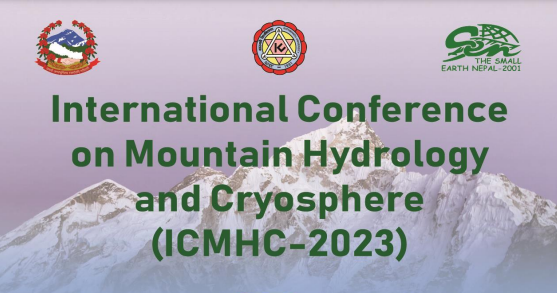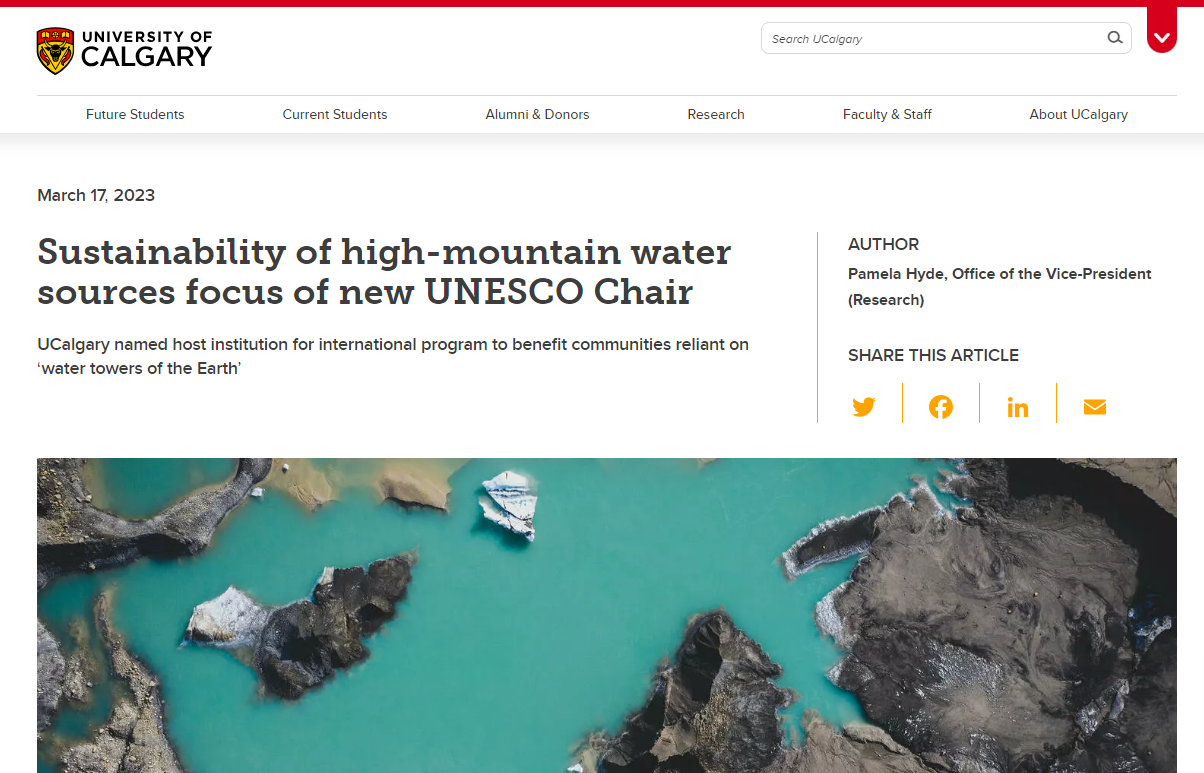On November 9 and 10, 2023, the Nepal Committee for the International Association of Hydrological Sciences (IAHS), The Small Earth Nepal (SEN), and Kathmandu University (KU) collaboratively organized the International Conference on Mountain Hydrology and Cryosphere (ICMHC-2023) in Lalitpur and Dhulikhel, Nepal. This prestigious event, supported by numerous renowned organizations, brought together experts, academicians, and researchers from various disciplines to delve into critical issues surrounding mountain hydrology, cryosphere and its related sectors.
The co-organizers for the conference were Tribhuvan University (TU), the Department of Hydrology and Meteorology (DHM), the Government of Nepal, Nepal Tourism Board (NTB), the International Center for Water Resources and Global Change (ICWRGC), the International Centre for Integrated Mountain Development (ICIMOD), International Water Management Institute (IWMI), Global Water Future (GWF) of the University of Saskatchewan, Society of Hydrologists and Meteorologists (SOHAM) – Nepal, and UNESCO. The other associated partners of the conference were the Nepal Academy of Science and Technology (NAST), Water Resources Research and Development Centre (WRRDC), Center of Research for Environment, Energy and Water (CREEW), and Real Time Solution Pvt. Ltd. (RTS).
The conference featured 10 technical and 3 formal sessions, encompassing 75 oral and 22 poster presentations. The conference covered diverse topics such as Snow Hydrology in a changing climate, Hydrological Modeling, and Water Quality. Discussions extended to Transboundary Water Resources, Hydro-meteorology in Agriculture, Cryosphere’s impact on Water Resources, Tourism, and Society, Glacier Mass Balance, Debris-covered Glacier, Permafrost Hydrology, and Water-induced Disasters like Avalanches, Glacier Lake Outburst Floods (GLOFs), Landslides, and Landslide Dam Outburst Floods (LDOFs). This allowed participants to exchange perspectives, share innovative research, and explore new insights into cryospheric changes, hydrological modeling, and climate change impacts.
Click here for details of all conference participants.
Formal Sessions
Dr. Dhiraj Pradhananga set the tone for the conference and welcomed all the participants. The inaugural session on day one, chaired by Prof. Dr. Rijan Bhakta Kayastha, incorporated esteemed guests and keynote speakers offering enlightening remarks. Dr. Gordon Young’s keynote speech on cryospheric issues in the Himalayas and Karakoram underscored the importance of understanding and addressing the impacts and challenges brought about by climate change on glaciers and snow masses.
Prof. Dr. Bhola Thapa, Vice Chancellor of Kathmandu University, Nepal was the chief guest in the inaugural session. The other speakers during the session were Dr. Luna Bharati, Dr. Manohara Khadka, Dr. Deepak Aryal, Dr. Arun Bhakta Shrestha, and Dr. Jagadishwor Karmacharya.
Chaired by Dr. Dhiraj Pradhananga, the second day featured notable three keynote speakers: Prof. Dr. Koji Fujita, Prof. Dr. John Pomeroy, and Dr. Anil Mishra, providing valuable insights into Himalayan Glacier Research, changes to snow and snow hydrology, and the importance of international collaboration in the face of cryospheric changes.
ICMHC-2023 concluded with a closing program at Kathmandu University, Dhulikhel featuring the announcement of the conference declaration by Dr. Melody Sandells and Dr. Chris DeBeer, and the distribution of certificates of appreciation to co-organizers and partners. Dr. Madan Lall Shrestha presided over the program, Prof. Dr. Hari K. Shrestha and Dr. Deepak Aryal provided remarks, all of them emphasized the importance of collaboration and knowledge dissemination in addressing the persistent impact of climate change on mountain hydrology and cryosphere.
Details of the conference sessions:
In the first special session, Snow Hydrology in a Changing Climate, Dr. Melody Sandells discussed the remote sensing of snow in high-mountain Asia, addressing challenges such as reduced water availability and changes in agricultural systems due to climate change. She emphasized the urgency to address impacts of changes in the precipitation phase and stressed the importance of collaboration, networks, and the need for new tools and technologies to these changing scenarios. Dr. Chris DeBeer presented the Common Observation Period Experiment (COPE) across global mountain research basins, emphasizing the impact of climate change on glaciers and river basins. He highlighted the rapid and pronounced retreat in Peyto Glacier, Canada, and the drought in the year 2023 at Bow River, Canada as climate change impacts. Srinivasarao Tanniru highlighted the importance of estimating snow depth in the western Himalayas of the HKH region using the SMRT model and passive microwave data and stressed the need for comprehensive sensitivity analysis of models. Sanjay Saifi presented an augmented reality-based snow visibility prediction system for regions prone to snowstorms and discussed its utility in cryosphere disaster management, as well as plans to incorporate haziness and other parameters. Esteban Alonso Gonzalez discussed an adaptive particle batch smoother for snow data assimilation, emphasizing the significance of assimilation algorithms. Dr. Juan Ignacio Lopez-Moreno focused on long-term changes in snow series in the Spanish Pyrenees, revealing statistically significant decreases in maximum annual accumulation and snow duration at various elevations.
Second session on Hydrological Modeling, Kimberly Tupaz discussed the application of the long short-term memory model in predicting hydrologic extremes in the Lancang-Mekong River Basin (LMRB) under climate change. She discussed that the research output can be used as a reference to policy and decision-makers for maintaining the sustainability and development of LMRB, farmers, fishermen, and local people living in the Mekong region. Dheeraj Mohan Gururani presented a study on morphometric analysis in the Nandhour-Kalish River Watershed, Uttarakhand, India, utilizing remote sensing and GIS. The results described the extreme steepness of the study area and the prioritization of sub-watersheds in that area. Ashish Devkota discussed runoff simulation in the Langtang River Catchment, Nepal using ERA5 reanalysis data and the ICHYMOD Hydrological Model, highlighting issues with ERA precipitation data. Susen Shrestha explored future water scarcity in the Adige River basin, Italy amplified by climate-induced receding glaciers, using the ICHYMOD model. Sue Walker presented the use of the Water-Energy-Food Nexus at the catchment level, emphasizing a multidisciplinary approach in the Crocodile sub-catchment, South Africa. Kundan Lal Shrestha discussed the coupling of the Glacio-Hydrological Degree-Day Model with PCRaster for spatial dynamic modeling of Himalayan River Basins, introducing the PYGDM model.
Third session focused on Water and Wastewater, Prof. Tjokorda Gde Tirta Nindhia’s study delved into the processing of cattle dung and cabbage waste in an anaerobic digester, emphasizing biomethane production for electricity generation. Dr. Narayan Prasad Gaire discussed multi-centennial streamflow reconstruction in Nepal using tree-ring studies, highlighting the importance of dendrohydrological potential. Madhusmita Nanda presented a study on groundwater recharge sources using stable isotopes for the Brahmaputra River Basin, emphasizing isotopic changes in the hydrological cycle. Michael van der Laan explored estimating water availability and consumption in the Upper Ewaso Ng’iro Basin, Mount Kenya, using a Water Footprint Approach, emphasizing the need for improved water management practices. Ashok Baniya discussed changes in water quality caused by the diversion of hydropower dams in Trishuli and Marshyangdi Rivers, Nepal, stressing the importance of incorporating water quality parameters in environmental impact assessments.
In the fourth session on Hydro-meteorology and its observation over mountains for modeling and agriculture, six presentations provided valuable insights. Paolo Porto discussed using radiotracers 137Cs and 210Pbex to estimate soil erosion rates and document climate change in mountain areas, emphasizing the importance of these techniques for predicting long-term climate-related changes. Ranjan Kumar Dahal focused on high-altitude hydrometeorology and geo-disasters in Nepal, highlighting the frequent occurrences of major disasters in the Himalayan region and the need for redesigned infrastructure projects to address climate-related challenges. Retinder Kour presented predictor screening for climate projection downscaling, discussing the significance of downscaling approaches in capturing regional climatic variability. Shamla D S explored landslide hazard mapping in Wayanad District, Kerala, incorporating copula-based estimation of the joint probability of rainfall to predict landslide triggers in the context of global warming. Shisher Shrestha discussed the potential of solar lift irrigation systems in Nepal’s mid-hills, addressing water scarcity and its impact on agriculture in the region. Finally, Deepak Paudel presented a case study on the effectiveness of climate-informed crop management decisions in paddy fields in Tulasi, Dhanusha district, Nepal, highlighting the positive outcomes of increasing crop productivity through informed decisions.
Fifth session discussed third-pole Climate Change, started with a presentation by Silian Pan on evaluating permafrost-related hazards in China based on Chinese literature, and showed an escalation in hazards within the Qinghai-Tibet Engineering Corridor due to the thawing. Nao Esashi presented an analysis of insoluble particles in the ice core from the Trambau glacier of Nepal. Ms. Esashi studied dust concentration variations over 146 years and suggested a link between the AMO (Atlantic Multidecadal Oscillation) and the atmospheric environment in the dust source area rather than just local phenomena. Prashant Baral provided a comprehensive review of climate change impacts and adaptation to permafrost change in High Mountain Asia underscoring insufficient monitoring of permafrost in the region considering the negative impact on the ecosystem and communities. The last presentation by Kyung Robin Kim was on estimating ground temperature and permafrost extent in High Mountain Asia using AIRS surface temperature and MODIS LST, underscoring the difficulty in estimating ground temperature influenced by permanent layers of ice and snow and permafrost because of its subsurface nature emphasizing the need for in-situ data.
Sixth session, Glacier and Glacial Lake Destabilizations and their Related Hazards in HMA started with Xueyuan Lu providing insights on catastrophic multi-phase mass flows in eight different glacierized catchments in the Southeastern Tibetan Plateau. The research highlighted the changes in temporal distribution and geomorphology in glacierized areas. The presenter further emphasized that such events will be more prevalent in the future due to global warming. Arindam Chowdhury presented on glacial lake dynamics and potential hazards in the Chhombo Chhu Watershed, Sikkim Himalaya as a result of climate change which revealed 27 lakes as potentially dangerous in the area. Ravindra Kumar presented an alternative to the time-consuming manual mapping with a fully automated and multi-data technique to map glacial lake inventory in High Asia.
Seventh session consisted of insightful presentations on Cryosphere, Society, and Tourism. Dr. Willington Ortiz emphasized addressing challenges and the opportunities for sustainable futures in Nepal’s mountain landscapes by enhancing electricity generation and distribution through mico-hydros incorporating a transdisciplinary approach. Rajiv Dahal introduced riparian areas for holistic and sustainable tourism given its ecological, cultural, and socio-economic significance. He further mentioned the environmental and economic sustainability riparian tourism could bring with strong collaboration among various organizations and governments. Amina Maharjan focused on the impacts of cryospheric changes on livelihoods for the Hindu Kush Himalayan Region resulting in outmigration and changes in governance and policy. Therefore, stressed increasing the resilience of communities against the impact of cascading disasters from cryospheric changes. Sumana Chhettri emphasized on the inclusion of women’s perspectives in decision-making to enhance water security in the mountain region of Nepal given they are at the forefront during drudgery works. Rajiv Dahal presented the need to reevaluate gaps and ambiguities in policy for Forest-Based Eco-Tourism (FBET) development in Nepal to preserve the essence of the FBET sector.
Eighth session provided information on Data Services in Disaster Risk Reduction (DRR) and Resilience Building for mountain and glacier environments. Dr. Luna Bharati discussed connecting global and local initiatives to local action and emphasized that data has no value if not transformed into information and knowledge and highlighted that lack of data is the major problem for sustainable water management. Stephan Dietrich presented the use of Global Water Data Centers for Early Warning and talked about the challenges and benefits of hydrological sharing and the benefit of sharing and accelerating data. Koen Verbist provided insights on the incorporation of a citizen science approach to access data in DRR and early warning systems to accumulate real-time data and build the capacity of communities and partners. Stefan Schneiderbauer discussed data repositories, data gaps and actions requested for DRR focusing on GLOFs. He talked about the Glacial Lake Outburst Flood (GLOF) process and the main challenges for prediction and mitigation. He also highlighted that there is not any UN convention and treaty for GLOF. Shailendra Shakya presented on the Community-based Flood Early Warning System (CBFEWS) and its role in enhancing communities’ resilience. He mentioned flood management practices in Nepal and its proven effectiveness in prevention and mitigation explaining how communities are informed about the early warning system.
Ninth session covered the understanding of Risks, Challenges, and Mitigation Strategies to address water-induced disasters and GLOF in the High Mountain Asia(HMA). Sudan Bikas Maharjan presented an investigation of the dynamics of Lower Barun Glacial Lake in the Nepal Himalayas which indicated debris flow and melting of ice as a threat to the lake’s outburst. Upendra Oli talked about novel approaches to reducing the risk of GLOF to safeguard lives and livelihoods in Nepal. Martina Zelenakova presented the climate change impact assessment of the trends in hydraulic variables for emphasis on hydrological risk. Dipesh Chapagain presented a case study on climate-induced disasters that showed a significant impact on disaster mortality in Western Nepal. The session ended with a presentation by Abhash Bhattarai on the characteristics of extreme floods in Nepal which demonstrated the extreme flow events occurring usually during the month of August.
Tenth, the last session consisted of presentations on Mountain Hydrology. Rizbi Buddhacharya presented a case study of the backwater effect due to the bridge structure at the Punyamata River in Shreekhandapur, Kavre, Nepal. The study concluded that minimizing the construction of pier bridges in low-lying areas is advisable due to their vulnerability to flooding. River training methods, encompassing strategies like embankments, spurs, and revetments, prove highly effective in averting flooding and inundation in these regions. Himani Bisht presented the formation of a flood inundation map using the HEC-GeoRAS Model for the Rispana River Catchment, in Dehradun, India. The flood map was required as increased rainfall patterns increased the extent of damage over time.
The conference discussed and highlighted research and initiatives in the field of Mountain Hydrology and Cryosphere playing a crucial role in collaboration, knowledge exchange and raising awareness for the persistent impact of climate change on the Mountain Hydrology and Cryosphere ultimately affecting the livelihoods of people living in these areas. The conference, while emphasizing the urgency to address the problems of climate change on Mountain Hydrology and Cryosphere, also provided innovative ideas, technologies and sustainable approaches that might be beneficial to address the problems.
Along with the oral presentations, there were poster presentations from various disciplines on both days of the conference which provided insights into the climatic conditions and their impact on the cryosphere and water resources as a whole affecting the communities. The posters presented covered different topics such as climate and hydrological modeling, GLOF analysis and modeling, changes in snow cover area and their impacts, wastewater treatment, and assessments interconnecting climate change with water-related diseases.
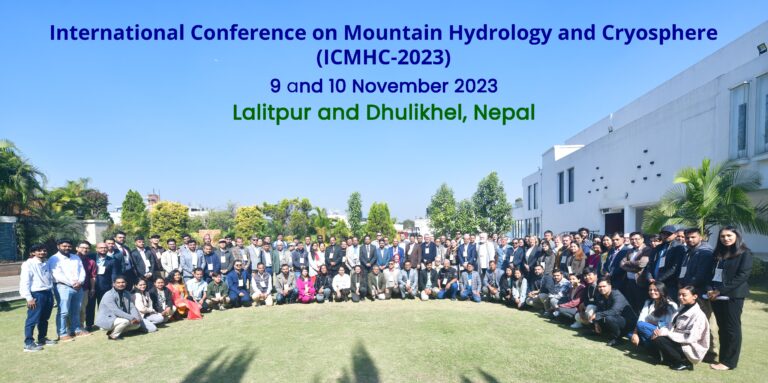
Participants on the first day of the ICMHC
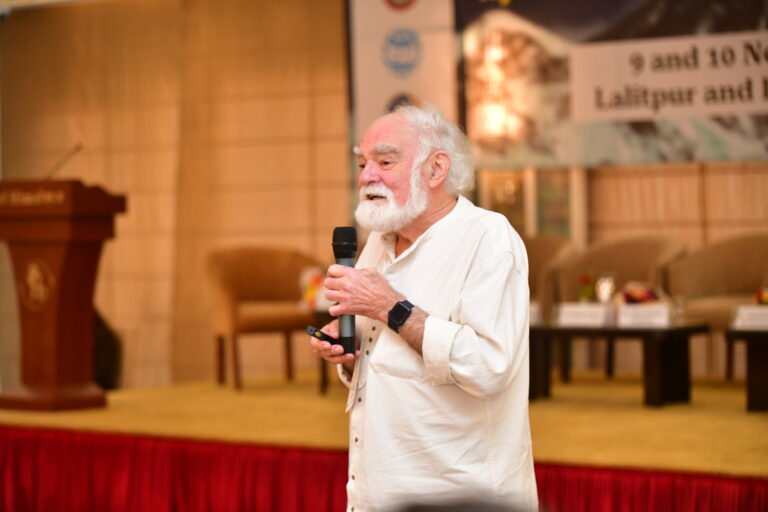
Keynote speaker Dr. Gordan Young
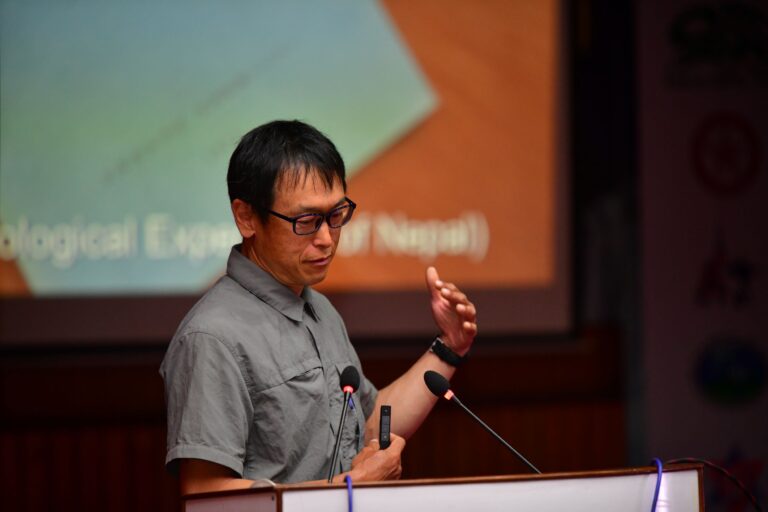
Keynote speaker Dr. Koji Fujita
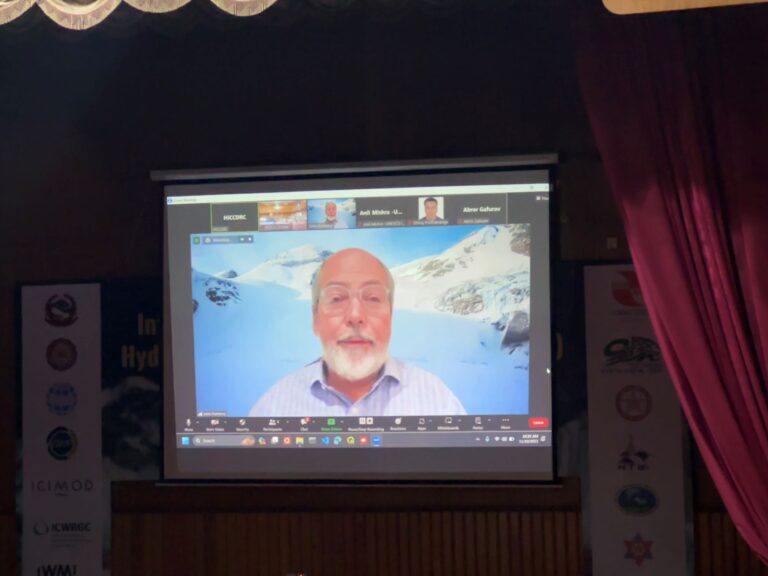
Keynote speaker Dr. John Pomeroy
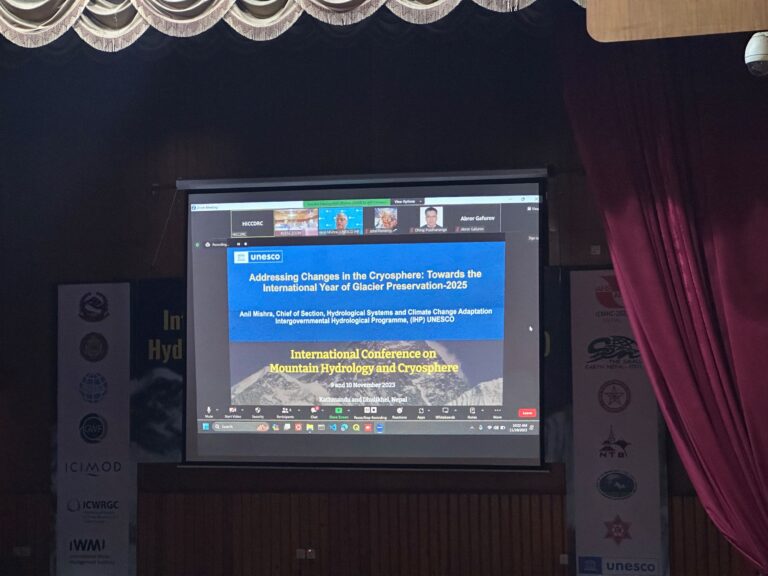
Keynote speaker Dr. Anil Mishra’s presentation
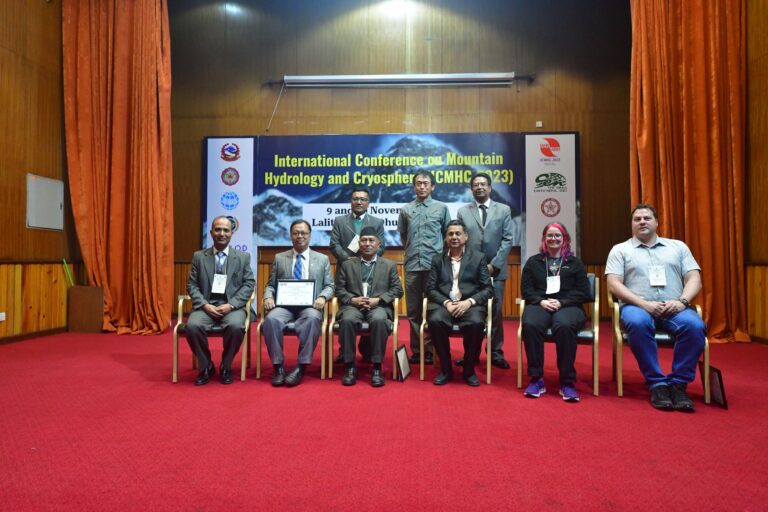
Closing ceremony


